Newsrooms attract their share of offbeat characters, and Fort Worth Weekly’s was no different one day in 2002. About a half-dozen reporters sat around a conference table joking and insulting one another to kill time while waiting for a staff meeting to begin.
Sweat stains marred the wrinkled T-shirt worn by a red-faced scribe who had lost his driver’s license after one too many elbow-bending offenses and been forced to commute by bicycle. Another writer – a grandmother in her 70s – wore a hippie-chick-meets-farmgirl outfit of loose clothes and flowing scarves, enjoying her old age by afflicting the comfortable and comforting the afflicted with award-winning investigative stories. Two people in the room had earned Pulitzer Prizes during their careers.
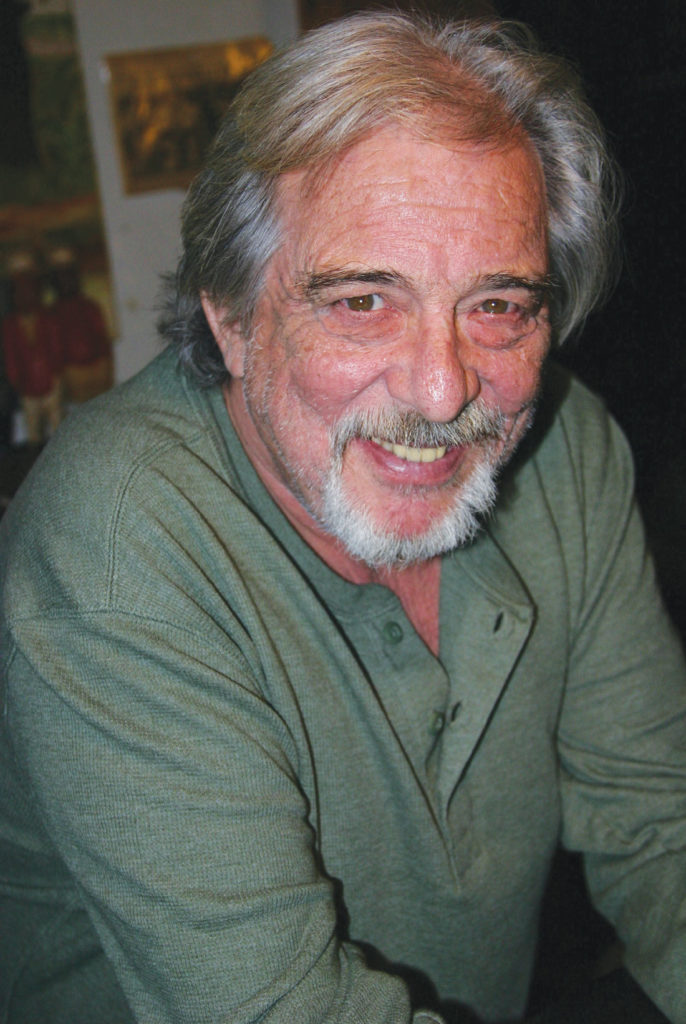
Photo by Jeff Prince.
This seasoned bunch didn’t surprise easily. Still, we were intrigued to meet a new freelance writer. Peter Gorman, a New York City native who had relocated to North Texas, had been a longtime writer and editor at High Times, the groundbreaking magazine that featured photos and stories about cannabis and the drug trade. Founded in 1974, the publication shocked squares, titillated stoners, and, similar to Rolling Stone and Playboy, established itself as more than a provocateur by offering credible journalism.
Gorman strode into the meeting room with a big smile and a surprising bounce in his step despite being in his 50s. Mischief danced in his eyes, and the wrinkled, baggy skin around them indicated Gorman had been immersing in the counterculture as well as reporting on it.
“I’m heah in a room with two Pultiz-ah Prize winnahs, and youse guys want to print my woik? Yes! Yes! Yes!” he bellowed in a gravelly voice with Queens, New York, saturating every syllable.
It was quite an entrance and typical of the outgoing and sometimes outrageous man who would continue surprising us for years, peeling away thin layers of his life during brief conversations in staff meetings or at the office Christmas party. Divorced. Kids. Moved to Joshua, south of Fort Worth, to help raise his youngest daughter, Madeleina. He’d met his ex-wife, Chepa, in the Amazon rainforest. She’d grabbed a machete to help him fend off a pack of drunken pirates, and he’d fallen in love with her.
Wait, what was that about pirates in the Amazon?
Gorman was among the first Westerners to ingest, experience, and write at length about ayahuasca, a hallucinogenic brew he refers to as “medicine” made from boiled jungle plants. In 1986, he wrote about ayahuasca’s mind-bending impact for High Times, the first magazine in the United States to feature an in-depth look at the substance.
A couple of years later, Gorman became the first to write at length about sapo, a substance derived from frog secretions. When ingested, sapo makes people vomit, defecate, and drop from exhaustion for a while before they come alive with adrenaline and heightened senses. The substance helps indigenous people hunt better.
After Gorman mentioned his pioneering work with sapo, some of us began referring to him as “Frog Licker.” He just smiled.
One day, Gorman announced at a staff meeting he was leaving the country and would be unavailable for a few weeks.
“You gonna lick frogs and run through the jungle?” I joked, as I usually did with Gorman, having never taken the time to seriously inquire about the nature of his trips.
“No, you don’t lick the frogs,” he said. “Frog sweat is too powerful if taken like that. It will eat through the membranes in your mouth and feel like a canker sore.”
“How do you get the frog stuff in your system?” I asked.
Our staff members stared wide-eyed as Gorman rolled up his shirtsleeves to expose two arms dotted with hundreds of small, round white scars. Peruvians burn their skin with red-hot twigs and rub the frog secretion into their wounds, introducing the substance to their bloodstream more slowly than if consumed orally. Gorman, who smokes Camels one after another, uses the hot ends of his cigarettes rather than twigs.
Those leprosy-looking arms made it clear – Gorman was a colorful character by any standard of measurement.
Many other scars decorate his body. In 2013, Gorman spent 11 days in a hospital and almost lost his right leg from flesh-eating bacteria contracted after falling into a pile of fish guts in Peru with open sores on his legs and no fresh water to clean himself. A large patch of skin between his ankle and knee hasn’t grown back despite several skin grafts.
Gorman spends much time in hospitals battling jungle-borne illnesses these days. I asked about other scars visible on his legs, and he described various stings and bites from bugs and snakes.
“Any monkeys attack you?” I said with a smile.
Gorman didn’t recognize it as a joke.
“You always get bitten by monkeys,” he said. “Lots of lizard bites. I’ve had dengue. Malaria. Botfly infestation – they lay eggs inside you that eat their way out. You itch. Then one day you watch these little critters jump out and fly away. It’s really gross. You’re a host.”
Often, Gorman would bring his young daughter with him to the office. Madeleina was sweet and inquisitive and would read or draw pictures while her dad attended meetings or worked on stories. As she grew older, she accompanied Gorman on assignments and took photos. Now, she is 21 and shoots freelance photos for the Weekly while attending college.
These days, ayahuasca has become trendy, and Gorman is something of a cult figure, a modern-day explorer, author, artifact hunter, and jungle guide willing to lead bankers, cops, housewives, filmmakers, and others deep into rainforests to elasticize their minds on spiritual quests. Imagine if Lara Croft and the Most Interesting Man in the World had spawned a lovechild who drank and smoked too much. That’s Gorman.
In 2010, he published Ayahuasca in my Blood: 25 Years of Medicine Dreaming, followed five years later by Sapo in My Soul: The Matsés Frog Medicine. His goal was to tell people “there are medicines we don’t understand, medicines that allow us to open the broadband of our souls and minds.” He hoped spotlighting nature’s remedies might help save the rainforests and the people who live there.
Ayahuasca contains DMT (dimethyltryptamine), classified as a Schedule I drug and illegal in the United States. Still, thousands of people from coast to coast attend ayahuasca ceremonies. Celebrities such as Chelsea Handler, Lindsay Lohan, and Sting have touted the brew. I notice comedians and mainstream sitcom characters joking about the potion. Last year, Viceland network began airing Kentucky Ayahuasca, a reality TV show.
“There is absolutely ayahuasca being poured every night in some apartment or yoga studio everywhere,” drug writer Lex Pelger told Vice in 2018. “All the states have people quietly doing this in the underground.”
Gorman doesn’t perform ayahuasca ceremonies in the states, only in Peru, he said. He’s made two or three trips a year for decades, taking psyche-scarred people with him to help them find liberation.
“I love introducing people to ayahuasca in the same circumstance in which I was introduced to it,” he said. “You go out to the middle of the deep jungle.”
Major publications have sent writers along to create first-person accounts of jungle trips. Several years ago, I was browsing a Men’s Journal magazine at a grocery store and spotted an article on Gorman. I laughed out loud as the writer described Gorman giving a pep talk to a group of people about to drink ayahuasca for the first time. Gorman sounded like a football coach giving a locker room speech, except the players were about to sprint into the psychological unknown instead of a gridiron.
“We’re going to tear down the curtain to another world,” Gorman told his group. “We’re like thieves, peeking into windows. Things are going to be looking back.”
Things looking back might be monsters, he warned.
If the monster is 1,000 feet tall, the group needed to imagine themselves as 2,000 feet tall, he said. Stay calm. Trust the medicine. But if things become overwhelming, “you just gotta grab your balls, ’cause you’re going down the monkey hole!”
In 2017, The Guardian newspaper referred to Gorman as the “ayahuasca king.” Numerous TV shows have profiled him. A North Texas filmmaker recently completed More Joy, Less Pain, one of several documentaries that have been made about Gorman. Most have focused on the ayahuasca angle. I wondered how a guy from Queens who talked like a Sopranos character became a jungle explorer and wound up in Texas writing for our little newspaper.
That backstory makes Forrest Gump look like a couch potato by comparison.
*****
The physical limitations that Gorman experienced early in life might have propelled him down the adventurer’s trail. Born in 1951, the sickly kid with juvenile rheumatoid arthritis sometimes languished in hospitals for weeks at a time beginning at age 5. Cortisone shots created other problems.
“I blew up to 180 pounds at age 8,” Gorman said. “I didn’t go to school until the third grade.”
When he finally attended school, he was so bloated and slow that classmates ran backwards while racing him at recess. Gorman’s health improved by age 10, and his parents encouraged him to throw himself into the world around him. His mother, Madeleine Gorman, voiced characters on radio shows, while dad Tom Gorman acted in plays on Broadway and wrote jokes for television personality Arthur Godfrey. The Gorman family lived frugally, and his parents preached and practiced hard labor spiced with creativity and fun.
“We were taught a good Irish work ethic,” Gorman said. “By age 6 or 7, we were expected to pay half our dental bills and doctor bills.”
After outgrowing his arthritis, he spent years inserting and delivering newspapers, building his strength and durability. He pursued a passion developed while being bedridden – writing plays. A couple of off-Broadway venues staged his plays while he was still in his teens.
Gorman began hitchhiking cross-country during high school summer vacations, exploring the West Coast and other places. His first attempt in 1968 went awry. An older friend, Don, invited Gorman to join him on a trip to West Virginia. They planned to co-write a story about coal miners.
“We thought, ‘If we write this, somebody will print it,’ ” Gorman recalled. “I always wrote just to write and trusted that the universe would get it out there.”
In early June of that long-ago summer, Gorman and his buddy stuck out their thumbs and found rides during the first two days. Luck fizzled on the third day, and they ended up crossing Delaware on foot.
“We were carrying canned foods in duffle bags that must have weighed 90 pounds,” Gorman said.
They ditched the cans to lighten their loads and kept going, eventually finding themselves tired, hungry, and foodless by the roadside. A discouraged Don called his mother to fetch him. Gorman called his mom, too. He’ll never forget her response: “Who is this? It’s not my son calling me. My son is not a chicken. My son would find something to do. My son is not welcome home until September.”
Mama Gorman had imparted a lesson.
“She wanted me to grow up,” Gorman said. “You don’t quit because things get tough.”
His mother knew someone in Kentucky and told Gorman to go there. Two days later, he was working on a tobacco farm, smacking worms with a rubber mallet in exchange for room and board. At summer’s end, his employer handed him $20.
Gorman relished the adventure.
“It hooked me on hitchhiking,” he said.
The next summer, he thumbed to California with $10. Along the way, he spent two weeks helping someone build a boat.
“I learned about building the hull of a boat, and then I moved on,” he said.
Motorists would pick him up and inevitably mention they needed someone to cut firewood or weed a garden.
“I’d work someplace and then continue hitching,” Gorman said. “I developed wanderlust early on.”
After high school in 1969 he moved out on his own.
“I found a small cold-water flat in Manhattan with a bathtub and a kitchen,” he said. “I spent my college years driving a taxi, working at art galleries, learning how to build things. Those skills lasted for years.”
Gorman showed me his New York City hack’s license that expired in 1976. He resembled a young Nicolas Cage in the black-and-white photo. Driving taxis meant discovering the city’s bizarre underside, an element that had piqued Gorman’s curiosity years before.
“As a kid, I had always been interested in that part of the city, the old 42nd Street with Skee-Ball and peep shows,” he said. “It was a little bit dangerous but interesting. I thought, ‘This is what people are into?’ I didn’t know. I grew up with nice people all around. To discover that people were into all these strange things was a revelation.”
Customers would climb into his cab at an airport and make any number of requests. Where could they get laid? Watch a cockfight? Play poker? Find drugs? Watch a cock get laid while playing poker on drugs?
“Instead of saying, ‘I don’t know anything about that,’ I’d say, ‘Well, how much you wanna pay?’ ” he said.
Gorman befriended doormen, bouncers, gamers, hustlers, and pimps.
“It was wonderful for a kid starting at age 19, driving a taxi,” he said. “I liked knowing where dogfights were. I didn’t like dogfights, but if people were going to do them, I liked knowing where they were. Who’s selling illegal cigarettes? Who’s making booze in their backyard? It was important information to have. ‘Let’s go to a place where poodles pee on people’s heads.’ Who would think of that? Driving a cab, people would make those requests. You realize they are serious. I better find out where that happens, so the next time a person asks me, I’ll say, ‘For $30, I’ll take you there.’ ”
In 1969, Gorman attended the nearby Woodstock music festival with friends and smoked weed for the first time. He liked the buzz but preferred the stronger hash that someone offered him.
He decided against taking LSD. One of his friends dropped acid at the festival and turned into a sexual deviant, groping women randomly.
“I had to follow him around, slapping his hand away,” Gorman said. “I had four sisters and knew that wasn’t OK. He finally went nuts.”
Gorman escorted his buddy to one of the onsite medical tents and ended up spending the next two days assisting other people experiencing bad trips. Gorman fed them bananas, talked them down, soothed them. He avoided the concert area altogether.
“I never liked crowds that much,” he said.
A couple of years later, Gorman was hitchhiking and stopped to work at a farm in West Virginia. One day, the farm owner handed him three hits of Window Pane acid. Gorman swallowed all three at once.
“I had no idea,” he said.
The next few hours were spent staring at trees along a ridge, convinced they could dance, communicate, and live secret lives when humans weren’t around.
“It blew my mind that there was a whole world that I didn’t know about, but if I could shift my vibration, which the LSD helped me shift, then I could see a whole different world,” he said.
Skepticism covered my face. Gorman continued.
“Think of a dog whistle,” he said. “You don’t hear it. Cats don’t hear it. Birds don’t hear it. But a dog damn sure hears it, so it’s there. If you could broaden your hearing wavelength, you could hear it. The LSD that day opened my eyes to the fact that things like trees have a certain kind of life. I didn’t realize how alive they were.”
Gorman kept taking LSD after he returned to New York City but eventually lost interest. The hallucinogenic effect became redundant after about 50 trips, he said.
“It was wonderful, but I was reaching the same place and no further,” he said. “With ayahuasca, I’ve never reached the ceiling. I’ve never seen the end of that.”
In his early 20s, Gorman began cooking at a restaurant near his apartment. He’d spent many years helping his mother prepare meals and developed a talent in the kitchen. For the next decade, he cooked at numerous restaurants and eventually managed several. He was comfortable, but wanderlust kept tugging at him.
In 1980, Gorman combined hitchhiking with his interest in hallucinogens and food.
“People told me if I got to Oaxaca, [Mexico], I would find lots of good mushrooms and fascinating markets,” Gorman said. “I was looking for something exotic. Mexico sounded good.”
Freedom and fulfillment co-mingled among the plants and rivers.
“I just fell in love with the jungle,” he said.
After he returned, Gorman’s girlfriend at the time sensed a change in him. Worried that Gorman was eager to go back to the jungle, she decided to deter him.
Her plan backfired.
“She bought me a book called Head Hunters of the Amazon by Fritz W. Up DeGraff,” he said. “It was written in the classic style, where on every page something important or disastrous happened, so you had to keep turning the page.”
You might think headhunters would be enough to scare someone away from the Amazon, but the book also described vampire bats, piranha fish, ants, mosquitoes, and every kind of biting bug imaginable, along with snakes the size of tree trunks and tarantulas large enough to eat birds.
Gorman was hooked.
“She bought me that book to steer me away from going to the Amazon, but it steered me exactly to the Amazon,” Gorman said. “It made me want to go up the Javary River, and the jumping-off point for that was Iquitos, Peru.”
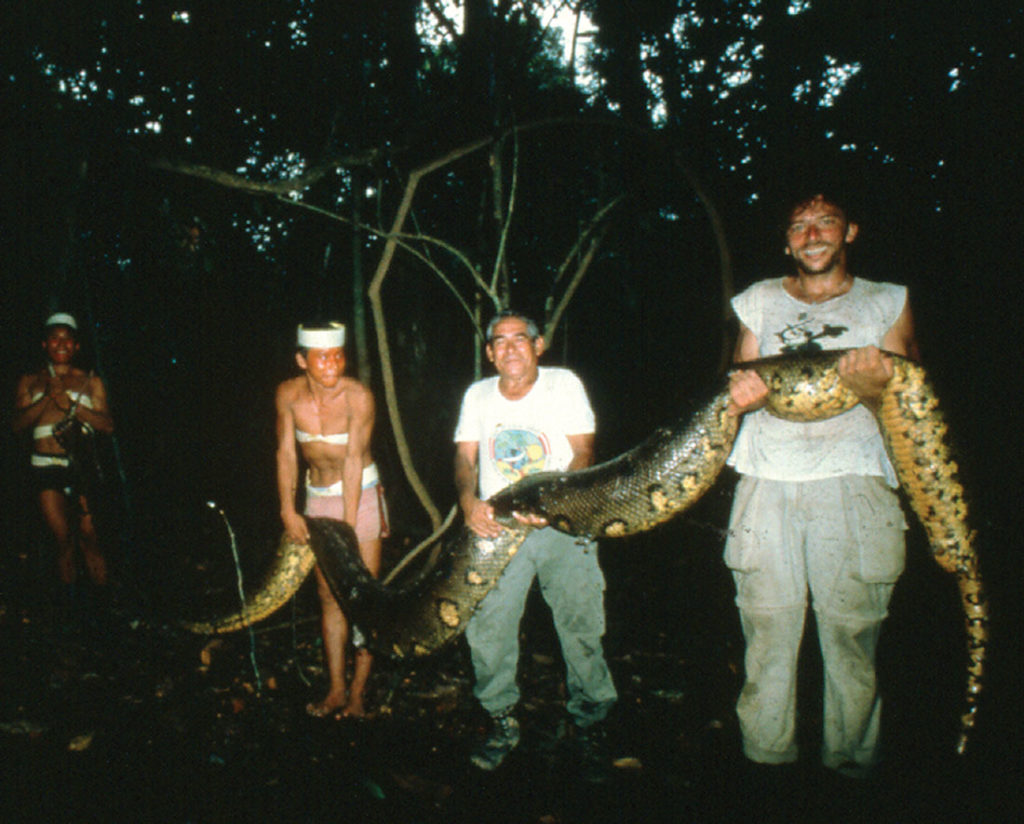
Off he went, spending two weeks in and around Iquitos in 1984. He would return many times and learn the jungle culture. He saw a hunter walk naked into a village carrying a wounded mama monkey in a sack made from tree bark. Riding atop the man’s head was a baby monkey, clinging to his long hair.
The hunter handed mama monkey to several women who stretched its body over a fire to burn off its hair in preparation for cooking.
“They grabbed the monkey by its arms and legs and roasted it alive,” Gorman said. “It was screaming, a big 14-pound monkey, and they held on to it. It was the cruelest thing I’d ever seen in my life.”
The women paid no mind to the monkey’s cries. The Matsés tribe members would wound animals to catch them but keep them alive as long as possible so the meat stayed fresh.
One of the native women was breastfeeding a baby. A fascinated Gorman watched as the hunter handed the orphaned baby monkey to her.
“She popped it onto her free teat,” Gorman said. “That was the kindest thing I’d ever seen, so in 30 seconds, I saw the cruelest and the kindest things I’d ever seen. I thought, ‘I have to spend time with these people.’ That’s what drove me back into deeper rivers.”
That’s where he discovered something he’d never encountered – ayahuasca.
“I had no idea what it was, but it had such a profound effect that I knew I had to come back and do that again,” he said.
Part of his experience, as he described it, sounded unbelievable to me. I hesitate to mention it now for fear of destroying Gorman’s credibility, but he has no qualms. Gorman described flying through clouds at supersonic speeds while accompanied by a large snake and visiting people he knew in the United States. He and the snake visited several friends in different cities. They flew to his sister Pat’s house at midnight and saw her drawing on a canvas. The spirit snake and Gorman made their way to his New York City apartment. An old friend, Chuck, was inside the house, which surprised Gorman. Chuck was supposed to have been visiting his girlfriend in another city.
After the ayahuasca wore off, Gorman took a boat to Iquitos and made phone calls. Chuck said he had changed plans and stayed at Gorman’s house unexpectedly, just as Gorman had seen in the vision. Pat, a graphic designer, said she’d been working late the night before, designing a poster for a client, when, at about midnight, she stood to stretch, and the image of a large snake appeared in her mind. Startled by the vivid mental image, she felt compelled to include the snake in the poster she was designing.
After hanging up the phone, Gorman was convinced he had traveled “astrally” while on ayahuasca, an experience he said he has repeated many times since.
“It’s strange to think you can go visit your friends anywhere in the world and just close your eyes and do it,” Gorman said. “We’ve been told that’s silly. Maybe it’s not silly.”
I asked how ayahuasca differed from LSD.
“LSD lets you know the trees are communicating with each other,” Gorman said. “Ayahuasca goes three steps deeper. Now you’re communicating with them.”
Gorman examined ayahuasca for GeoMundo magazine in Central America, Geo in Germany, World in Spain, and Omni and Science in the United States.
Soon after, he had begun writing about frogs and sapo. The first time he tried sapo in 1986, Gorman was creating an English-Matsés dictionary, pointing to different things in a hut and asking an aborigine what the items were called. Gorman pointed to a small sack hanging above a fireplace and was startled when the native burned him with a hot stick without warning and rubbed paste into the wound.
What happened next panicked Gorman.
“I kind of threw up and pooped myself and peed a little bit, and spit was coming out of my mouth,” Gorman recalled. “I thought, ‘I’m going to die. They poisoned me.’ Then some little kids came around and started kicking me. They weren’t kicking me hard like to hurt me. It seemed like they were kicking me to see if I was dead yet.”
Gorman’s final thought before blacking out was that the villagers were going to cook and eat him like a monkey. He awoke on a hammock and could hear clearly two villagers having a conversation 100 yards away.
“Then I looked up in the trees and saw some motion,” he said.
Through leaves of faraway trees, he saw monkeys that he never would have spotted before. He could smell them even. He felt strong and alive.
“I started making notes,” he said.
The sapo allowed Gorman to maneuver through the jungle like a master. Before, he had been crawling slowly across logs that stretched over dangerous rivers. Now, he was crossing them with confidence and expert balance.
“I had no idea I was bringing back a new thing that was going to be important and the scientific world would look at it,” he said. “I was just writing a story about an experience. I was the right person at the right time.”
Today, sapo, also called kambo, is an important element of the supercleanse crowd that swears it reduces depression, gastrointestinal problems, high blood pressure, and other ailments despite inconclusive medical research. Sapo isn’t regulated in the United States and is legal for consumption.
People travel from around the globe to little ol’ Joshua just to sit with Gorman and participate in sapo ceremonies. Last year, I dropped by Gorman’s house on a Sunday morning after he had hosted a weekend ceremony. About a dozen people had attended – young, old, men, women, black, white, brown – and all of them were beaming. Most hadn’t slept in 48 hours but were bright-eyed, effusive, energetic, and happy. They gushed over Gorman’s generosity of spirit, praising his willingness to open up his home (and toilet, which is important), cook for them, mentor them, and administer medicine. He charged no money and did it out of love for humanity.
The only one who was quiet that day was Madeleina. She has spent many years of her young life helping her dad host sapo ceremonies, including cleaning up more than her share of errant vomit and whatnot. While the visitors to her home were glowing with joy, Madeleina appeared tired and sad as she fed the family chickens in the backyard.
What nobody could ignore was the sight and sound of Gorman. Not only had he administered the medicine for his guests, he had used it himself – three doses in two days. Day 3 without sleep had begun for Gorman by drinking a full bottle of red wine for breakfast. The bags under his bloodshot eyes were swollen twice their size, and the lines in his face were deeper than ever. He stood in his backyard singing folk songs at the top of his lungs while chain-smoking Camels and watching the morning sun crawl up the sky.
*****
In 1993, Gorman was captaining a boat down the Galvez River in Peru, accompanied by Chepa, a Peruvian woman he’d just met who knew the river well. Four days downriver, a boat pulled up beside them. Onboard were a dozen drunk and rowdy men. A couple of them made moves to jump onto Gorman’s boat. He urged Chepa to hide below deck and began waving a machete and cursing the men. They could overtake him easily, but he was prepared to fight to protect the wad of cash he carried in his pocket to purchase supplies and bribe officials.
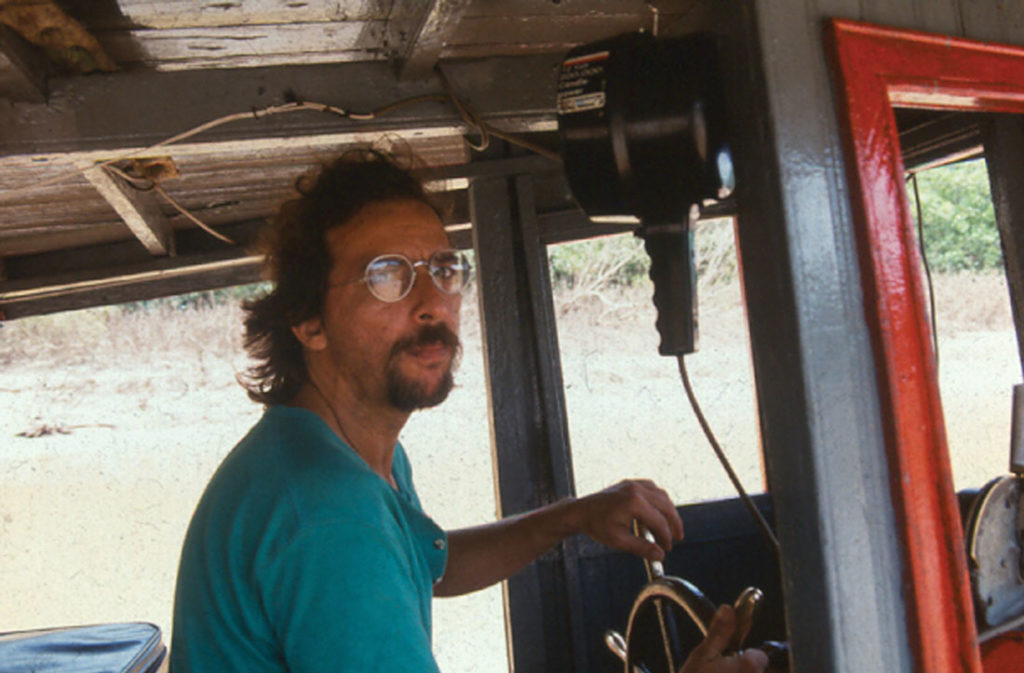
As the standoff intensified, Chepa appeared beside him, waving her own machete and yelling. She and Gorman held off the men, who mocked Gorman for relying on a woman for protection but eventually went on their way. Afterward, Gorman told Chepa he’d fallen in love and was going to marry her. She laughed, but a year later they were hitched. Gorman adopted her two young sons and brought his new family to New York City. Chepa became pregnant, and Madeleina was born.
Before long, Chepa left her new husband, relocating to Fort Worth where she had relatives. Baby Madeleina went with her. Gorman knew little of Texas but wanted to remain close to his daughter, so he followed behind and bought the small, modest frame house in Joshua with the large, private backyard. He began freelancing for various publications, and Fort Worth Weekly hired him as a staff writer in 2006. Since then, Gorman has won numerous awards for his stories about oil and gas drilling in the Barnett Shale, the Keystone pipeline controversy, the drug trade, and border wars. The Houston Press Club has twice named him print journalist of the year.
I have long respected Gorman as a journalist and man but have refused several invitations to participate in his sapo rituals over the years. He mentioned it again not long ago.
“What’s the point?” I said. “Burn myself, rub in frog juice, and make myself puke, poop, and pee for what?”
He described being able to look out a window and see the serrated edges of leaves from far away.
“I don’t care about the serrated edges of leaves,” I said.
“Your body will operate at a higher level than it is operating at now,” he said.
“What would I do then? Solve a Rubik’s Cube?”
“If you felt like walking, you’d walk better,” he said. “If you felt like listening to music, you’d hear notes you’ve never heard before. The elimination of toxins that hold you down makes you feel lighter.”
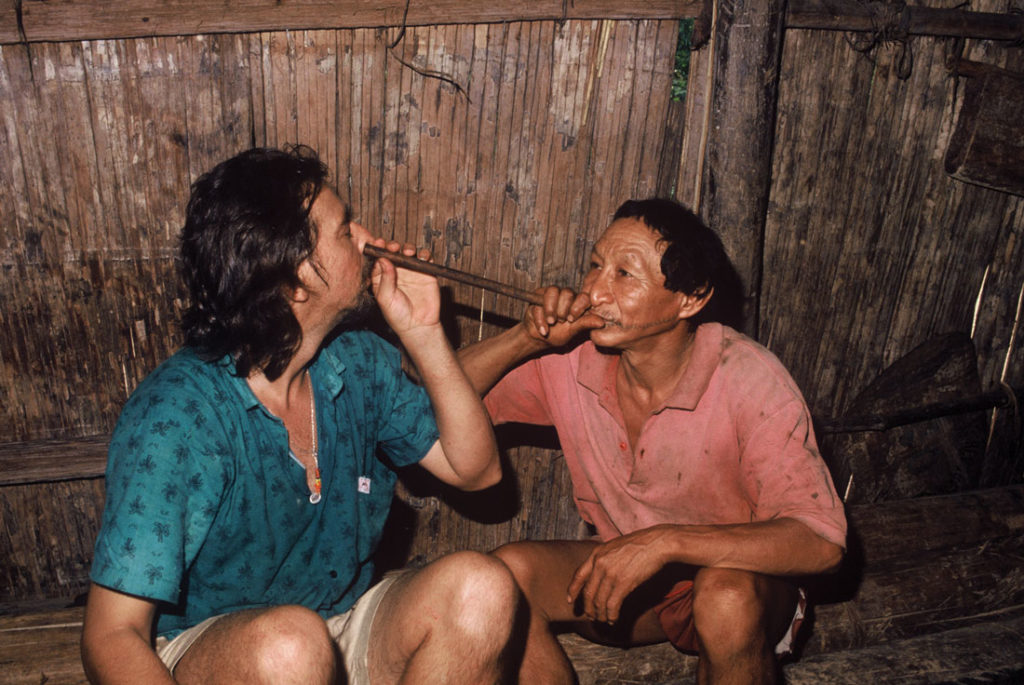
During staff meetings over the years, Gorman has claimed he maintains the “organs of a teenager” because of the jungle juice flushing toxins from his system. His claims of perfect health were often interrupted by his world-class smoker’s cough, a deep, gurgling hack that sounds like the death rattle of the Marlboro Man. Gorman is overweight, short-winded, pockmarked, and near-crippled at times. He wears baggy shorts, even in winter (he claims he doesn’t own a pair of pants), and shirts with lots of pockets to hide miniature bottles of whiskey that he taps into throughout the day for medicinal purposes.
To us, he looked like walking death.
Once again, I passed on Gorman’s offer to use sapo. He shrugged and didn’t mention it again. I was relieved. I’d spoken to numerous ayahuasca enthusiasts and all expressed surprise that I wasn’t planning on tripping as part of my research. Many writers have taken that gonzo approach, I said. I didn’t think it necessary. Besides, I was profiling Gorman, not ayahuasca.
The enthusiasts disagreed. Some grew suspicious, viewing me as an interloper. How could I flesh out the ayahuasca king without taking his journey?
Gorman chuckled when I mentioned his cult-like status among devotees. He enjoys his celebrity but said the medicine doesn’t define him. He takes more pride in being a good father and investigative journalist, he said.
“When people think of Timothy Leary or people of importance in the psychedelic world, they imagine these are just addled or crazy drug people,” he said. “I remain a worker, a dad, someone who’s got to get the laundry done and has already done two loads today, someone who has to vacuum the rug even though I don’t feel like it. People want to pigeonhole some of us who work on the outside. The medicine is taken seriously, but my life revolves around being a human.”
Not everyone shares that perception, particularly the person closest to him.
*****
In January, Gorman left for Peru to lead a group of seekers deep into the rainforest. A month later, he returned to Joshua feeling feverish and weak. An old nemesis – malaria – had resurfaced. Also, Gorman’s legs were swollen to twice their size and covered in lesions. He was content to ride out the pain at home while self-medicating with wine, whiskey, and Camels and relying on his daughter for care. On February 22, Madeleina forced him to see a doctor.
Gorman described the visit afterward: “The doctor said, ‘Do you want to go to the hospital?’ I said, ‘No.’ He said, ‘Well, you don’t have a choice – you’ve got two days to live. You’re infected from your fucking toes to your fucking forehead!’ ”
I could hear Gorman smoking a cigarette as he spoke.
“I’m glad you called,” he said. “I’m going to the hospital in an hour. Madeleina’s got me packed up and bought me a couple of books to read.”
I told him he sounded remarkably calm.
“I really hurt,” he said in a low voice. “The malaria is just knocking me on my ass this time, coupled with the infection and the lesions. I’m soaking wet. My sneakers are dripping water from my legs.”
Ever the joker, he ended our conversation by saying, “Hopefully, they’ll give me some good Jell-O.”
The next day, Madeleina described in a shaky voice what happened after she and her dad arrived at Texas Health Huguley Hospital in nearby Cleburne. Doctors diagnosed Gorman with bacterial infections, put him in the intensive care unit, and pumped him full of drugs. He was sleeping, Madeleina said, but his breathing and heartbeat were erratic.
“The nurses did a CAT scan to see what was going on and came back and said, ‘Did you know you had a fractured leg?’ ” she said.
Gorman had broken his fibula without realizing it.
Madeleina sounded frantic.
“My dad has been sick pretty much my whole life,” she said. “In and out of the hospital. Something has always been wrong. When you’re a kid, you don’t realize what’s going on. Now it’s a lot harder to deal with.”
Three days later, I called her again. Gorman was feeling better, she said, and nurses had moved him from ICU to a regular bed – and chastised him for smoking cigs in his room.
During our conversation, Madeleina sounded more upset than she had earlier. I asked what was wrong, and she unloosed a long, bitter rant between tears. She resented having a father who prioritized adventure, vices, jungle medicine, and strangers above his family. She blasted him for saying his parental absences were justified by the good he brought to the world from helping people find peace.
She wasn’t buying it. She’d seen Gorman limp home from one too many quests.
“He’s a really selfish dad, and he has always been,” she said. “I’m tired of saving him. If I didn’t make him go to the doctor, he’d be dead. I’m the only one willing to put up with the nonsense.”
After a few minutes, she grew self-conscious and apologized for her words. I told her she sounded like someone speaking honestly, someone weary of watching a person she loved self-destruct. Other coworkers and I had also noticed Gorman’s increasing fragility over the years, the excruciating cough and growing number of scars and illnesses.
Madeleina had watched it up close her entire life.
“I’m very tired,” she said. “I know my life is wonderfully easy and full of privilege, and I live in the Top 10 percentile of the world, but I’m a very tired 21-and-a-half-year-old, and he either needs to make himself better and do better or just fucking die.”
Her dad could improve his health if he tried, she said. Instead, he appeared content to dose himself with stimulants and pursue far-flung escapades rather than enjoy a pastoral life in Joshua, close to family, raising chickens and writing news stories.
Madeleina insisted that her criticisms be included in this article, hoping they might impact her dad. She has shared the same feelings to his face many times, she said, but he doesn’t seem to listen. Maybe seeing them in print will drive her point home, she said.
Then she added a final thought.
“Call me on a good day,” she said. “I’ll tell you how much I love him.”



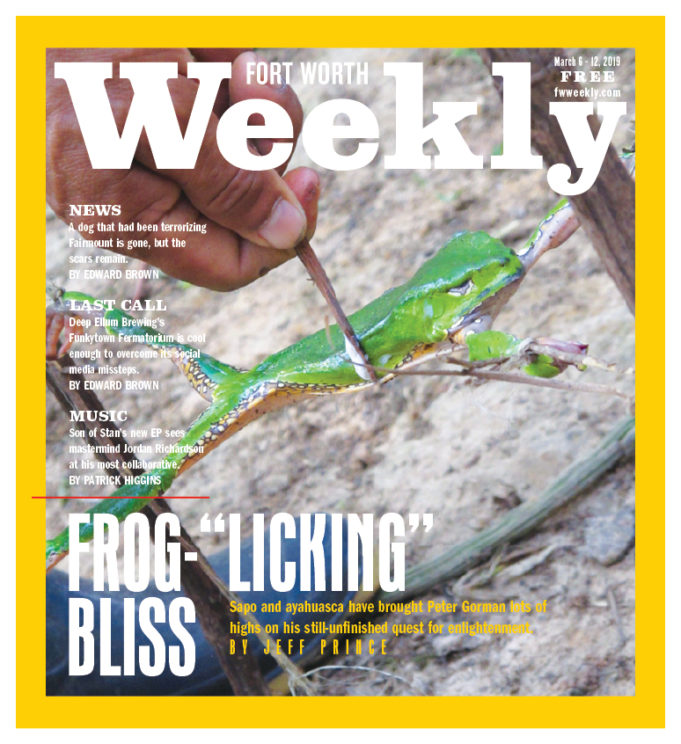









Except for the fact that I stopped drinking anything but wine several years ago, you did a terrific job, Jeff. Thanks.
Peter Gorman is a legend! It is an honor and a privilege to call him my friend. Madeleina adores her dad and to witness their connection is deeply moving. Until you’ve met someone like Peter Gorman, you haven’t really lived – and let’s face it, there’s *no one* like Peter.
Quite a man glad to call him a friend like I always say you are the man Peter Gorman thank for all you do part!!!
What a ride!
Nice story on a very interesting guy. No jungle for me though.
Great work, Jeff. God bless Peter and Madeleina, two of the bravest, strongest, brightest, selfless and loving people I know. I can’t think of one without the other, although one of them is much more sympathetic than the other when a dinner guest finds himself barfing his guts out on their dining room table for an hour and ruining every clean towel in their house.
Jeff, you should post your ayahuasca son and write a sapo song. Maybe a Broadway musical about Peter is in order. How about a tony bennent style ballad called “I left my leg in Amazonia”? 😉
Incredibly fascinating story! Love you, Peter Gorman!🍄🍄🍄
Fantastic story, Jeff! I laughed out loud and teared up in different places. In your story, I found a beautiful investigation into the life of a very interesting man that presents insight into what it means to be human for all of us.
I just love how leftist celebrate dysfunction and insanity. Sad really.